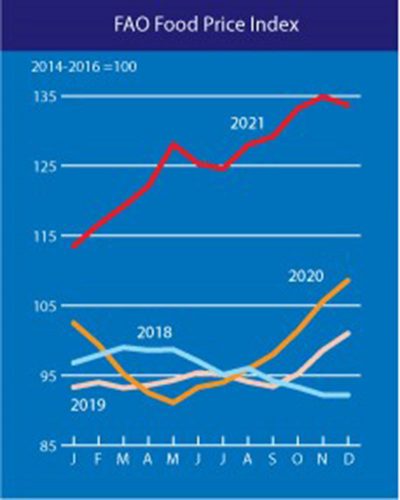The report published on January 6, 2022 by the United Nations Food and Agriculture Organization (FAO) on the FAO Food Price Index confirms what many of us already feel in our pockets. Food prices are continuing to rise, and not just in Guyana.
In 2021, the FAO Food Price Index continued to trend upwards, reaching a 10-year high, despite a few months which registered small reductions, including December. In fact the 2021 FAO Food Price Index was just over 28% higher than 2020.
 The FAO Food Price Index is a well-recognized tool that tracks monthly changes in commonly traded international food commodities – cereals (including rice), Vegetable Oils, Sugar, Meat and Dairy. Roughly, it indicates how much countries may expect to pay for these types of commodities in global markets (import), but also what prices countries might expect to receive for their food exports.
The FAO Food Price Index is a well-recognized tool that tracks monthly changes in commonly traded international food commodities – cereals (including rice), Vegetable Oils, Sugar, Meat and Dairy. Roughly, it indicates how much countries may expect to pay for these types of commodities in global markets (import), but also what prices countries might expect to receive for their food exports.
The factors contributing to the rise in individual commodity prices are numerous and interact in complex ways. Food production levels (supply), particularly among leading producers are of course important. In December 2021, global poultry prices declined somewhat, primarily due to increased global exportable supplies. However, also important to price changes are the levels of stocks on hand that are available to the market. This is often seen with cereals such as wheat and maize.
Demand also plays a role in food prices. Seasonal demand for Christmas drove temporary increases in the price of some types of meat on global markets.
Speculation also plays a part in food price fluctuations. Market speculation on expected demand and on the potential impact of weather and environmental conditions on projected production can drive up or depress prices. The COVID-19 pandemic has further introduced significant cost increases in freight and logistics. For example, “maize and wheat prices were 44.1 and 31.3 percent higher than their respective 2020 averages, mostly on strong demand and tighter supplies, especially among major wheat exporters.”
For a country such as Guyana, the situation of the global food commodities will have mixed impact. As an exporter, Guyana is affected by global prices it will receive for exports of rice and sugar. It is welcomed news that rice production is progressing well. In the cereal price index, rice registered a slight decline (4%) in price in 2021, compared to 2020 levels but importantly, it continues to be higher than pre-COVID-19 levels. In this case, the small price decline is reported to be a result of ample global supplies and increased competition among suppliers. For its part, Guyana continues to have stable markets for its rice and remains the number one rice producing country in the CARICOM.
As with other countries, Guyana is also feeling the impact of higher prices for imported food (processed and raw materials), feedstock and farming input supplies. “For 2021 as a whole, the FAO Cereal Price Index increased by just over 27 percent from 2020 and the Index stands at the highest annual average registered since 2012. Both wheat and corn, significant components imported for food manufacture in Guyana, are included here.
For 2022, we can likely expect that global and national food systems will continue to grapple with conditions that will impact food prices. In addition to seasonal fluctuations in production and demand, it is expected that backlog and interruptions in global shipping and logistics, uncertain labour availability, the pandemic and impacts of climate and weather events will all continue to have their effect on food prices.
Guyana’s food system will have to continue providing safe, healthy affordable food for all, as well as to provide livelihood opportunities for our farming communities, it is more critical than ever to follow the comprehensive path to national food systems transformation that Guyana outlined at the UN Food Systems Summit – social protection for the most vulnerable; continuous improvement in production and food distribution efficiency, to keep prices competitive; embracing diversification of agriculture with technology and digital innovation; streamlining the current and emerging value chains; pursuing trade with shorter supply chains and reducing the risk in agriculture. There are few short term solutions that will be sustainable. The answers lie in the longer haul.
Dr Gillian Smith is the FAO Representative in Guyana.









